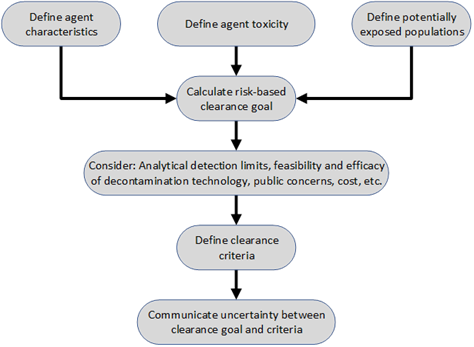Chemical incident consequence management activities may parallel those of a HAZMAT response; however, the elevated scale of the nationally significant chemical incident and the level of public concern will involve the coordination of many agencies. The decisions related to consequence management phase activities (e.g., clearance decisions for contaminated areas, decontamination technology, final resumed use/re-occupancy) will likely receive high-level technical review and depend greatly on the information gathered throughout the crisis and consequence management operations. Many incident-specific factors (e.g., the types of chemicals released, their degradation byproducts, the amount released, how they were released, and collateral hazards) will have an impact on response decisions. The discussion of multi- agency coordination is provided here to guide decision-makers through the response process, including the identification of risk-based cleanup goals and ultimate clearance criteria.
This section describes the major steps and decisions in the process for defining site-specific clearance criteria. The processes listed below, although presented sequentially, can be performed concurrently during across the various operational phases of chemical incident response and recovery as discussed in Section 2 above. Figure 7 outlines the components for developing clearance criteria (the quantitative or qualitative measures evaluated to determine the attainment of the clearance goal). This process is intended to be flexible; it includes the evaluation of the specific hazardous chemical contaminant, the potentially exposed population, and the analytical realities at the time of the contamination event. A step- by-step-by-step illustration of the decision-making process is provided in Appendix D.

- Estimate Risk-based Clearance Goals
- Using site-specific information on chemical identity, exposure, and health effects, determine appropriate risk-based clearance goals defined by or using method developed by federal or state agencies for appropriate exposure durations.
- Using site-specific information on chemical identity, exposure, and health effects, determine appropriate risk-based clearance goals defined by or using method developed by federal or state agencies for appropriate exposure durations.
- Consideration of Site-specific and Stakeholder Issues
- Provisions should be made to incorporate stakeholders’ perspectives into clearance discussions.
- Consider issues that are unique to the site-specific circumstances that may impact the attainment of risk-based clearance goals:
- Feasibility issues (analytical detection and laboratory capacity)
- Uncertainties/confidence (availability, confidence in, impact of historical inequities, interpretation and application of exposure guidelines, sampling methods/validation, decontamination approach effectiveness)
- Time/resource concerns (extent of contamination, critical infrastructure/items, economic impacts of cleanup options, environmental justice)
- Other confounding factors (the variety of uncertainties involved in the initial; nature and toxicity of breakdown products and collateral hazards; disproportionate impact on communities of color, low-income communities, and other underserved or historically marginalized communities; waste generation; etc.).
- Consider adequacy of verification that clearance criteria have been successfully achieved with appropriate evaluation of clearance sampling and analysis of air, building surfaces, soil, surface water, ground water, drinking water, as needed.
- Consider options for decontamination methods (e.g., monitored natural attenuation; thermal degradation; or solid, liquid, foam, gel, vapor or gas decontamination technologies) to determine which approach(es) will provide adequate cleanup efficacy.
- Risk Communication
- Determine the potential magnitude of difference between the desired risk-based clearance goal and the clearance criteria.
- Develop a risk communication strategy that adequately describes the clearance criteria and the uncertainties associated with the attainment of clearance goals, such as:
- Basis for clearance goals
- Potential for residual contamination
- Institutional controls that may remain
- Long-term monitoring.


